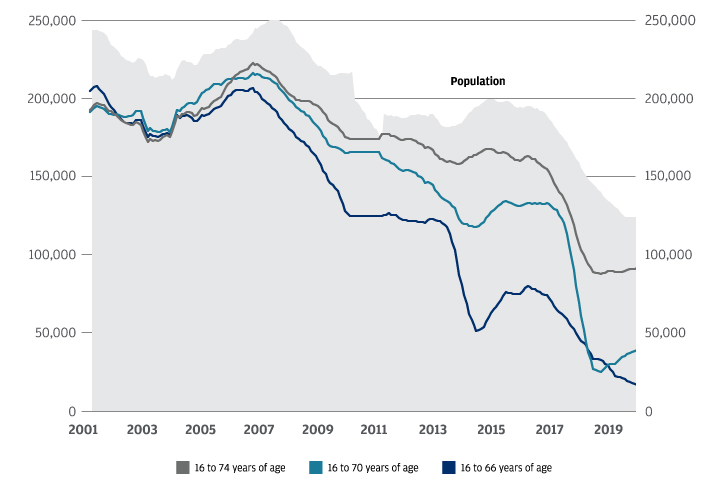JPMorgan Chase Bank, N.A. Member FDIC. Visit jpmorgan.com/cb-disclaimer for disclosures and disclaimers related to this content.
From startups to legacy brands, you're making your mark. We're here to help.
-
Innovation Economy
Fueling the success of early-stage startups, venture-backed and high-growth companies.
-
Midsize Businesses
Keep your company growing with custom banking solutions for middle market businesses and specialized industries.
-
Large Corporations
Innovative banking solutions tailored to corporations and specialized industries.
-
Commercial Real Estate
Capitalize on opportunities and prepare for challenges throughout the real estate cycle.
-
Community Impact Banking
When our communities succeed, we all succeed. Local businesses, organizations and community institutions need capital, expertise and connections to thrive.
-
International Banking
Power your business' global growth and operations at every stage.
Key Links
Prepare for future growth with customized loan services, succession planning and capital for business equipment.
-
Asset Based Lending
Enhance your liquidity and gain the flexibility to capitalize on growth opportunities.
-
Equipment Financing
Maximize working capital with flexible equipment and technology financing.
-
Trade & Working Capital
Experience our market-leading supply chain finance solutions that help buyers and suppliers meet their working capital, risk mitigation and cash flow objectives.
-
Syndicated Financing
Leverage customized loan syndication services from a dedicated resource.
-
Commercial Real Estate
Capitalize on opportunities and prepare for challenges throughout the real estate cycle.
-
Employee Stock Ownership Plans
Plan for your business’s future—and your employees’ futures too—with objective advice and financing.
Key Links
Serving the world's largest corporate clients and institutional investors, we support the entire investment cycle with market-leading research, analytics, execution and investor services.
-
Institutional Investors
Putting your long-tenured investment teams on the line to earn the trust of institutional investors.
-
Markets
Direct access to market leading liquidity harnessed through world-class research, tools, data and analytics.
-
Prime Services
Helping hedge funds, asset managers and institutional investors meet the demands of a rapidly evolving market.
-
Global Research
Leveraging cutting-edge technology and innovative tools to bring clients industry-leading analysis and investment advice.
-
Securities Services Solutions
Helping institutional investors, traditional and alternative asset and fund managers, broker dealers and equity issuers meet the demands of changing markets.
Key Links
Providing investment banking solutions, including mergers and acquisitions, capital raising and risk management, for a broad range of corporations, institutions and governments.
-
Center for Carbon Transition
J.P. Morgan’s center of excellence that provides clients the data and firmwide expertise needed to navigate the challenges of transitioning to a low-carbon future.
-
Corporate Finance Advisory
Corporate Finance Advisory (“CFA”) is a global, multi-disciplinary solutions team specializing in structured M&A and capital markets. Learn more.
-
Development Finance Institution
Financing opportunities with anticipated development impact in emerging economies.
-
Sustainable Solutions
Offering ESG-related advisory and coordinating the firm's EMEA coverage of clients in emerging green economy sectors.
-
Mergers and Acquisitions
Bespoke M&A solutions on a global scale.
-
Capital Markets
Holistic coverage across capital markets.
Your partner for commerce, receivables, cross-currency, working capital, blockchain, liquidity and more.
Key Links
A uniquely elevated private banking experience shaped around you.
-
Banking
We have extensive personal and business banking resources that are fine-tuned to your specific needs.
-
Investing
We deliver tailored investing guidance and access to unique investment opportunities from world-class specialists.
-
Lending
We take a strategic approach to lending, working with you to craft the right financing solutions matched to your goals.
-
Planning
No matter where you are in your life, or how complex your needs might be, we’re ready to provide a tailored approach to helping your reach your goals.
Whether you want to invest on your own or work with an advisor to design a personalized investment strategy, we have opportunities for every investor.
-
Invest on your own
Unlimited $0 commission-free online stock, ETF and options trades with access to powerful tools to research, trade and manage your investments.
-
Work with our advisors
When you work with our advisors, you'll get a personalized financial strategy and investment portfolio built around your unique goals-backed by our industry-leading expertise.
-
Expertise for Substantial Wealth
Our Wealth Advisors & Wealth Partners leverage their experience and robust firm resources to deliver highly-personalized, comprehensive solutions across Banking, Lending, Investing, and Wealth Planning.
For Companies and Institutions
-
Commercial Banking
From startups to legacy brands, you're making your mark. We're here to help.
-
Institutional Investing
Serving the world's largest corporate clients and institutional investors, we support the entire investment cycle with market-leading research, analytics, execution and investor services.
-
Payments
Your partner for commerce, receivables, cross-currency, working capital, blockchain, liquidity and more.
-
Credit & Financing
Prepare for future growth with customized loan services, succession planning and capital for business equipment.
-
Investment Banking
Providing investment banking solutions, including mergers and acquisitions, capital raising and risk management, for a broad range of corporations, institutions and governments.
For Individuals
-
Private Bank
A uniquely elevated private banking experience shaped around you.
-
Wealth Management
Whether you want to invest on you own or work with an advisor to design a personalized investment strategy, we have opportunities for every investor.
Explore a variety of insights.
Key Links
Insights by Topic
Explore a variety of insights organized by different topics.
Key Links
Insights by Type
Explore a variety of insights organized by different types of content and media.
Key Links
We aim to be the most respected financial services firm in the world, serving corporations and individuals in more than 100 countries.
Key Links
- Insights
- Economy
- Jobs Recovery
- Could the labor shortage boost productivity?

By Jim Glassman
Head Economist, Commercial Banking
By Jim Glassman
Key takeaways
- A record 9.2 million job openings went unfilled in May.
- The nation’s aging workforce is creating a persistent labor shortage. Retiring baby boomers leave the workforce almost as fast as new graduates and immigrants enter the job market.
- A labor shortage could incentivize businesses to invest in technologies that allow smaller staffs to be more productive.
- For workers with the right skills, rising productivity will create opportunities.
- Wages could see a sustained climb as businesses adapt to a new labor market dynamic.
What's behind our persistent labor shortage
Job openings are at a record high, and the pandemic is only partly to blame. Over the past decade, job creation consistently outpaced the growth of the working-age population. Many companies will find labor shortages to be an ongoing challenge.
- Pandemic closures and reopenings churned the labor market. A stabilizing business climate should quickly erode this spring’s record-setting spike in vacancies.
- However, the pre-pandemic economy logged 7 million job openings at the peak of the last business cycle right before shutdown.
- The baby boom generation’s retirement has dramatically slowed workforce growth:
- In the 1990s and early 2000s, the economy needed to create around 200,000 jobs every month to keep up with population growth.
- Today, the workforce is growing by only about 50,000 monthly. Job creation above this level is likely to eliminate labor market slack quickly.
Monthly change in working-age population
(16-70 years old; change in thousands monthly)


Policies and raising wages won’t go far enough
There is no straightforward way to expand the workforce. Policy shifts like immigration reform and unemployment benefit cuts are unlikely to entice enough workers to fill the emerging shortage. In local battlegrounds over talent, companies may seek to entice more workers with higher wages and more benefits, but this could lead to other challenges.
- Immigration reform may have limited power to grow the workforce. Net immigration flows have plateaued over the past decade, largely due to rising prosperity in the developing world.
- Supplemental unemployment insurance benefits are frequently blamed for job vacancies, but the expiration of benefits this summer will likely do little to expand the workforce.
- The market solution to labor scarcity—higher wages—may not be viable in a globally competitive economy. Consumers may turn to imports if the price of domestic goods rises in response to climbing wages.
Leaping beyond the productivity gap
As labor becomes scarce, businesses will need to find a way to increase production without taking on new staff. The likely answer is an old one—automation—but a combination of surging productivity and labor scarcity could put workers in an advantageous position.
- In the past, advances in IT and automation displaced workers. Technologies made offshoring possible and devalued some types of routine labor.
- This pushed corporate profits up, benefiting stockholders—but hardly lifted wages.
- Artificial intelligence promises to enhance technologies like enterprise resource planning (ERP) systems, which help employees work more efficiently.
- Such growing efficiency would place skilled workers in a strong position to reap the rewards from their productivity. Instead of becoming redundant or replaceable, they will likely be bringing more value to the workplace.
- As always, wage growth is likely to be concentrated among workers with the skills to fully harness new technologies. So training and reskilling investments will be essential.
What to watch
In the near term, watch the pace of job creation. If it continues to outstrip population growth, a labor shortage is coming. In the longer run, look to productivity and wages’ share of GDP for signs of relief.

Jim Glassman, Head Economist, Commercial Banking
Jim Glassman is the Managing Director and Head Economist for Commercial Banking. From regulations and technology to globalization and consumer habits, Jim's insights are used by companies and industries to help them better understand the changing economy and its impact on their businesses.
Hear more in our weekly Economic Take podcast
Related insights

Economy
Data to decode: The economics of being a business owner
May 01, 2024
Set your organization up for long-term success using 10 key economic indicators to track and inform your decisions.

Economy
Apr 19, 2024
Understanding the factors driving the price of gold, and some of the reasons it could be effective in a portfolio construction.

Economy
Consumer trends: 2008 vs. today
Aug 09, 2023
Our experts look at how U.S. consumer habits and preferences have evolved since the global financial crisis — and how businesses can continue to adapt.

16:12 - Economy
Research Recap | El Niño and the impact on agriculture
Jul 26, 2023
In this episode of Research Recap, discover how El Niño will affect crop yields and other commodities.

Economy
How Does the Debt Ceiling Progress From Here?
Apr 21, 2023
The U.S. Debt Limit debate is back in the limelight after taking a backseat to the banking sector tumult in March. Two catalysts are driving the recent headlines.

Economy
Steps your company can take to be recession-ready
Aug 24, 2022
How do you define a recession? We offer three strategies for business leaders to consider during periods of heightened volatility and slower economic growth.

Economy
Government contracting trends: Surviving economic challenges
Apr 19, 2022
Contractors continue to face uncertainties driven by supply chain disruptions, worker shortages and inflation.

Economy
Stagflation is not here to ruin our economy once again. Here’s why.
Oct 25, 2021
Current fears appear overblown. Yes, inflation is rising. But we believe it will remain at a manageable rate.
You're now leaving J.P. Morgan
J.P. Morgan’s website and/or mobile terms, privacy and security policies don’t apply to the site or app you're about to visit. Please review its terms, privacy and security policies to see how they apply to you. J.P. Morgan isn’t responsible for (and doesn’t provide) any products, services or content at this third-party site or app, except for products and services that explicitly carry the J.P. Morgan name.